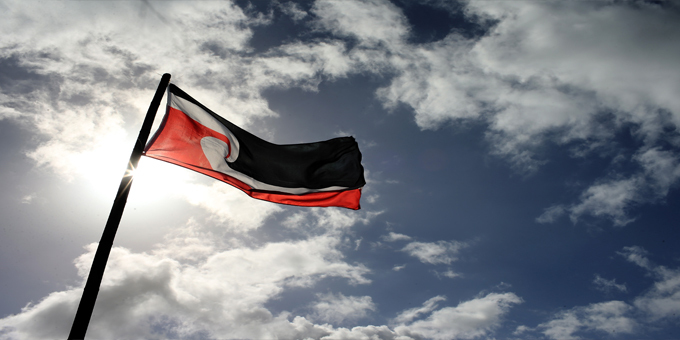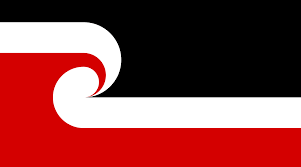![]() Mana News- Hilda Halkyard-Harawira
Mana News- Hilda Halkyard-Harawira
Me tupu i a wīwiī me tupu i a wāwā, turia ki te wera, me piri tonu ki te korito o te rengarenga, me whakapakari ki te hua o te kawariki.
Flourish in many places as you face the fires of adversity; cling to the heart of the rengarenga as sustenance for your soul, and to harden you for all that lies ahead of you; be like the fruit of the kawariki, small in size, large in deed, and ready to flourish in the most adverse of conditions.
The idea of a Māori flag was borrowed from the Australian Aboriginal flag. It was a symbolic icon used in 1980s to gather indigenous people of Australia to key events; sprinter Cathy Freeman later ignited much discussion re her victory lap with the Aboriginal flag after winning double gold at 1994 Commonwealth games.
In the lead up to the 150 commemoration of the Treaty signing- a national hui of Māori activists in 1989 considered several campaigns to bring awareness to the plight of the Treaty of Waitangi and ongoing legislative abuses to Māori. The Crown had millions of dollars to promote a wonderful co-existence with the Treaty Partner. Māori activists under the mantle of Te Kotahitanga or The Movement -had no money.
Getting arrested was boring, predictable and time consuming- and is to be saved for special occasions. The Movement wanted to use their creative talents to promote awareness of ongoing Māori grievances. . Ngāti Kahungunu & Ngāpuhi activists promoted kaupapa music- waiata reo Māori. Tuhoe began an awareness campaign to reclaim their whenua. Others went into storytelling through contemporary art. Far North group Te Kawariki embarked on a campaign to set up a Māori flag competition to inspire Māori to have hope in a time- where Māori were struggling to realise kaupapa Māori education, land claims and high unemployment. The Kotahitanga hui sought a flag that would appeal to Māori of any politics or religion- a flag of Māori identity and pride.
The final winning Māori flag now commonly referred to as the Tino or Tino Rangatiratanga flag was created by 3 women from Tai Tokerau: the late Hiraina Marsden(Ngai Takoto), the late Jan Dobson Smith (Patu Harakeke) and Linda Munn (Patu Harakeke). The flag was taken to several hui in the North, the design was modified a few times and flown at Waitangi in 1990. Reddish brown represents Papatuanuku- the earth mother. The white represents Te Ao Marama and the koru reminds us that life is continually in renewal and ongoing. Black represents Ranginui- the sky father. No matter what, there is a natural order in the universe- the earth and sky embrace the world of the living. The natural colours and its simplistic depiction of the world led to an early acceptance of the flag by many MĀORI in different walks of life.
After much consultation Te Kawariki set a kaupapa with the flag:
1) that the flag dimensions not be changed
2) and the kara should not be worn on the kotore ( derriere, bottom)
3) that the icon be used by any group supporting and promoting kaupapa Māori and not for personal gain;
4) that the original artists wanted any royalties to go towards setting up a Māori arts wānanga in Ngāpuhi;
Te Puni Kokiri hosted 22 public hui throughout the motu 2009 to ascertain which kara could serve Māori. All hui recognised other flags which meant significant things to hapu, Iwi and the nation. Each marae has the mana to fly its own flags. In Australia- the Aboriginal flag is flown at state events- as the government has invested in two flagpoles.
And finally now that the kara is to be recognised as a national Māori flag- that ownership remains with Māori people-not with the Crown.
6th Feb, 2010 the Māori flag was handed over to rangatahi Māori as the next generation of kaitiaki.
July 2015, the tino flag sold cheaply in Aotearoa is more readily available- and solves number 3. . Be wary of some kara versions that have a narrow white strip which alter the flag dimensions. The kara is not owned by any one political party or faith- mā tātou katoa.
H Halkyard-Harawira , For Te Kawariki a group of Treaty activists from the Far North Tai Tokerau 1985—


